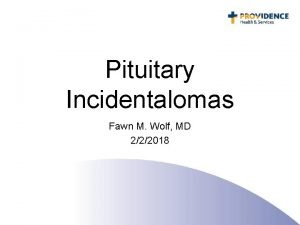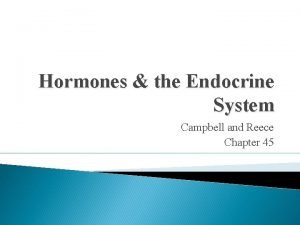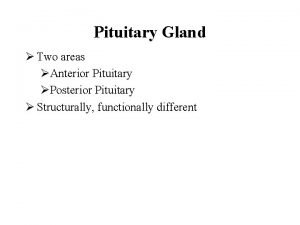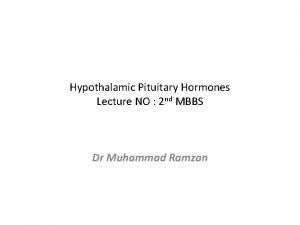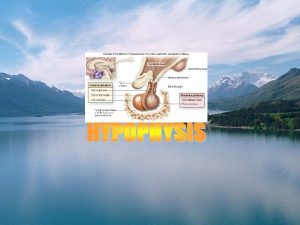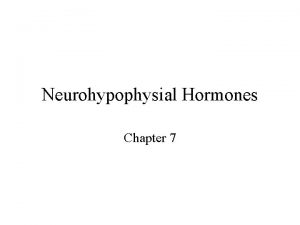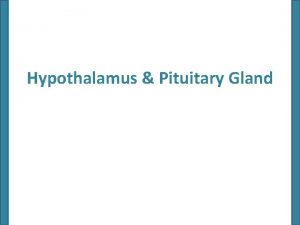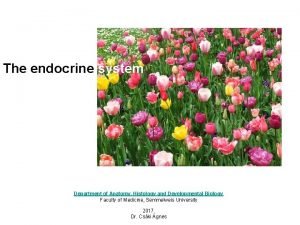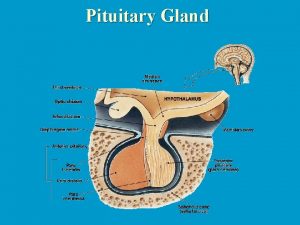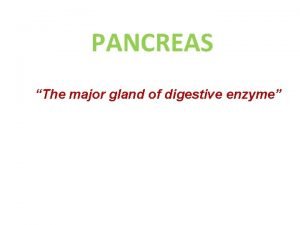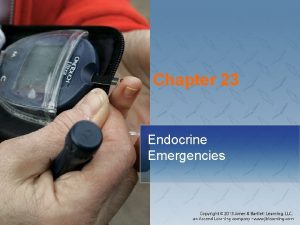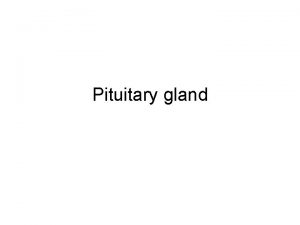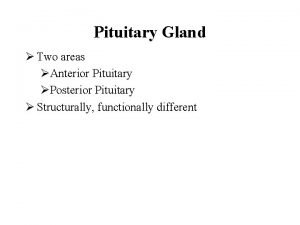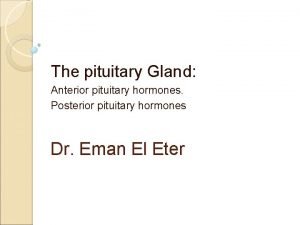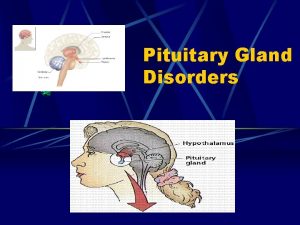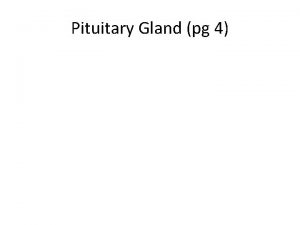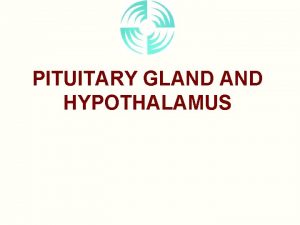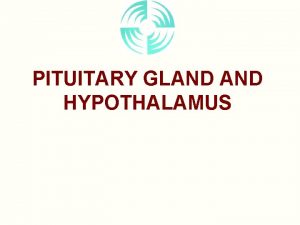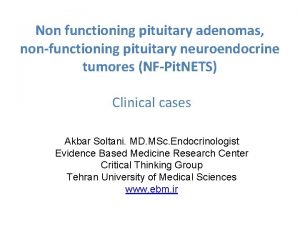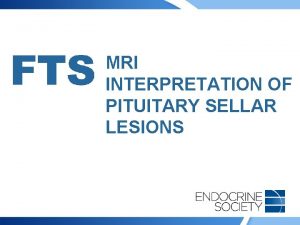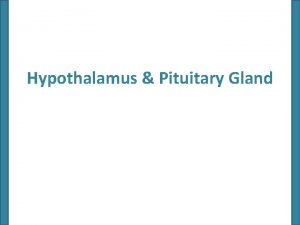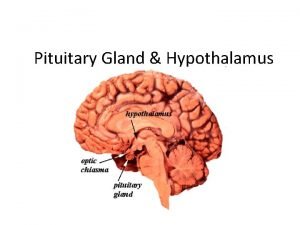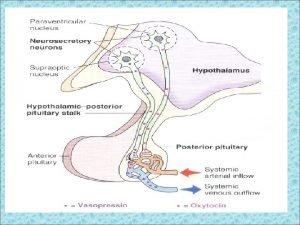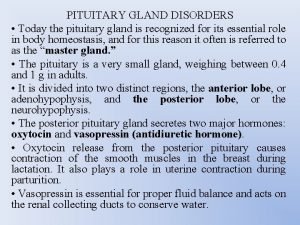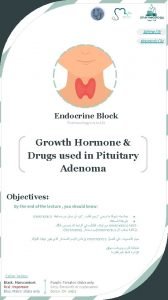Pituitary Incidentalomas Fawn M Wolf MD 222018 Outline
























- Slides: 24

Pituitary Incidentalomas Fawn M. Wolf, MD 2/2/2018

Outline • • Prevalence Clinical presentation and evaluation Natural history Management





Over 18, 000 pituitaries examined at autopsy: -10. 6% contained adenomas (1. 5 -27%) -Frequency similar for men and women and across all age groups -Vast majority were microadenomas

Prevalence of Incidentalomas on Imaging • Incidentally discovered signal abnormalities < 10 mm (hypodensities): – CT: 4 -20% – MRI: 10 -38% • Incidental macroadenomas on CT/MRI are quite rare: 0. 1 -0. 2%

Differential Diagnosis of Incidental Pituitary Masses • • Adenoma: functional or nonfunctional Hyperplasia, infarction, hemorrhage Craniopharyngiomas, Rathke’s cleft cyst Meningioma Malignancy: metastases, primary pituitary Infiltrative: sarcoidosis, TB/fungal Inflammatory: hypophysitis (autoimmune, etc) Physiologic hypertrophy: pregnancy, puberty, primary hypothyroidism • Normal variant: large pituitary

Final Clinical Diagnoses of 282 Incidentalomas

Final Histopathological Diagnoses of Incidentalomas

Pituitary Adenomas are Common Is it causing any: • Hormonal hyper secretion? • Hormonal hypo secretion? • Mass effects?

Endocrine Evaluation: Functional Adenomas • Prolactin. 10 -40% of adenomas are prolactinomas – ALWAYS test • Acromegaly (growth hormone): IGF-1. 2 -10% of adenomas are GH secreting. • Cushing’s disease (ACTH): cortisol. 1 -15% of adenomas are ACTH secreting. – Consider testing • FSH/LH • TSH – Generally don’t test

Endocrine Evaluation: Hypopituitarism • Macroadenomas and larger microadenomas (6 -9 mm): – Common, screening recommended • Smaller microadenomas (<6 mm): – Hypopituitarism rarely occurs – Screen only if clinically indicated

Evaluation for Hypopituitarism • FSH/LH: common, occurs in 30 -70% of patients – Pre-menopausal women: menstrual history • Normal: no labs needed • COCP: labs unhelpful • IUD: labs may be helpful, especially if FSH/LH and estradiol are low – Post-menopausal women: • No HRT: draw FSH, should be elevated • HRT: labs unhelpful – Men • FSH, LH, total +/- free testosterone

Evaluation for Hypopituitarism • ACTH: 20 -40% – Central adrenal insufficiency – 8 am cortisol or cosyntropin stimulation test • GH: 10 -50% – IGF-1: neither sensitive nor specific. Falsely low: obesity, insulin resistance. – Stimulation test: insulin, glucagon • TSH 20 -40% – Overtly low free T 4 (or significant drop from known baseline), with inappropriately normal or low TSH • PRL: – Inability to lactate; overtly low PRL typically only seen following apoplexy or with certain medications (aripiprazole)

Additional Work-up • Formal visual field (VF) testing for all patients with a macroadenoma, or a microadenoma abutting the optic nerves or chiasm, even if there are no apparent visual symptoms • Pituitary dedicated MRI (fine cuts though the sella w/w/o gadolinium), if initial study was a CT or brain MRI

Natural History of Incidental Nonfunctional Adenomas: Review of 8 Series

Natural History: 2016 Canadian referral based registry • 328 patients with incidentalomas included • 52% female, median age 55 years • 73% adenomas, of which 25% were functional and 36% had secondary hormonal deficiency (SHD) • 71% presented with macroadenomas

Natural History: Risk of growth and worsening hormonal status

Indications for Surgery • Visual field deficit, ophthalmoplegia or neurological compromise due to the lesion • Lesion abutting/compressing optic nerves or chiasm • Apoplexy with visual disturbance • Functional tumors, other than prolactinomas • Consideration of surgery: significant growth over time, hypopituitarism (with resolution in 15 -50% of patients), lesions close to the optic chiasm with plans for pregnancy


Take Home Points • Pituitary adenomas are very common: 10% prevalence on autopsy series • History and physical necessary to assess for visual compromise, hormonal hyper- or hyposecretion • Check prolactin in all pituitary incidentalomas, and consider screening for cushings and acromegaly • Macroadenomas: more likely to grow and cause visual compromise, also more likely to lead to hypopituitarism

References • 2016 Analysis and Natural History of Pituitary Incidentalomas. Eur J Encrinol 175(1): 1 -9 • 2012 Best Pract Res Clin Endocrinol Metab 26(1): 9 -19 • 2011 Pituitary Magnetic Resonance Imaging for Sellar and Parasellar Masses: Ten Year Experience in 2598 patients. J Clin Endocrinol Metab 96(6): 1633 • 2011 Natural History of Nonfunctioning Pituitary Adenomas and Incidentalomas: A Systematic Review and Metaanalysis. J Clin Endocrinol Metab 96(4): 905 • 2011 Pituitary Incidentaloma: An Endocrine Society Clinical Practice Guideline. J Clin Endocrinol Metab 96(4): 894 • 2008 Nonfunctioning Pituitary Tumors and Pituitary Incidentalomas. Endocrinol Metab Clin N Am 37: 151. • 1994 Am J Neuroradiol. 15(4): 675 • 1994 Ann Intern Med. 120(10): 817 • 1997 Radiology 314: 287 • 1937 Am J Pathology Vol 12: 205
 Fawn wolf md
Fawn wolf md Dr elrington
Dr elrington Brass wolf
Brass wolf Brush wolf vs timber wolf
Brush wolf vs timber wolf Konrad wolf judith catherine wolf
Konrad wolf judith catherine wolf Flight flight freeze fawn
Flight flight freeze fawn Summary of the chapter this is jody's fawn
Summary of the chapter this is jody's fawn Fight flight freeze fawn test
Fight flight freeze fawn test What is a quote sandwich
What is a quote sandwich Anterior pituitary
Anterior pituitary Hypophyseal fossa and pituitary gland
Hypophyseal fossa and pituitary gland Anterior pituitary hormones
Anterior pituitary hormones Anterior pituitary gland
Anterior pituitary gland Pituitary gland division
Pituitary gland division Subdivision of pituitary gland
Subdivision of pituitary gland Circulação
Circulação Diaphragm sella
Diaphragm sella Hypothalamus gland
Hypothalamus gland Difference between anterior and posterior pituitary
Difference between anterior and posterior pituitary Hypothalamus and pituitary gland connection
Hypothalamus and pituitary gland connection Endocrine organ histology
Endocrine organ histology Oxytocin
Oxytocin Structure of posterior pituitary gland
Structure of posterior pituitary gland Chapter 23 the endocrine system
Chapter 23 the endocrine system Histology of pituitary gland
Histology of pituitary gland
